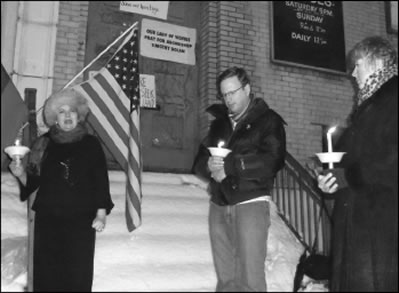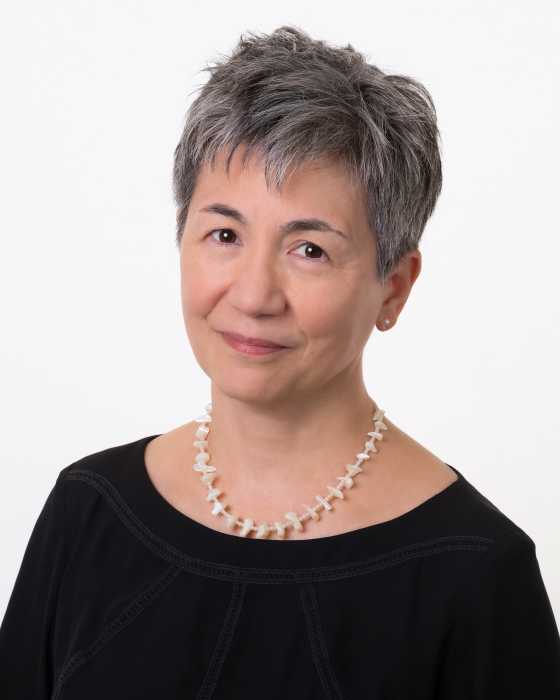By Lincoln Anderson
Undaunted by the heavy snowfall that left Our Lady of Vilnius’s steps buried beneath a deep layer of white, a dozen supporters of the shuttered Soho church held a vigil outside it last Friday evening. Holding candles and bundled up against the cold, they prayed their small, yellow-brick church would someday open its doors to them once again.
First, they shoveled a path up the middle of the steps to clear an area to put candles, a small crucifix and an icon of Our Lady of Vilnius — a so-called “black Madonna” because of her dark face. In the snow, they stuck Lithuanian flags — yellow, green and red — along with American flags. On the church’s red doors they tacked up signs: “God Never Closes His Doors,” “Save Our Heritage” and “Stalin 1939 — Egan 2007.”
It was the third anniversary of the church’s padlocking by Edward Egan, former cardinal of the Catholic Archdiocese of New York. To justify its action, the archdiocese cited a damaged roof support beam and a dwindling congregation.
The church was built by an enclave of Lithuanian longshoremen and their families who lived in the area before the Holland Tunnel’s construction uprooted them, seeing them resettle in the Bronx and the suburbs.
Former congregants and supporters filed a lawsuit to block the church’s demolition. A court-issued restraining order, in effect since April 2009, has ensured that Our Lady of Vilnius, though unused, is still standing.
Ramute Zukas, president of the Lithuanian-American community in New York City, said she sent a letter to the new archbishop, Timothy Dolan, and that he agreed to meet with them to talk about matters of concern to Lithuanian Catholics — but only if Our Lady of Vilnius is not discussed.
“I think ethnic churches are under attack,” Zukas said. “They’re being targeted for closure.”
A steady stream of cars made their way into the nearby tunnel entrance on Broome St., their tires audibly swishing in the slush as the small group gathered in a circle, each to share his or her thoughts in turn. About three-quarters of them spoke in Lithuanian, with their comments translated into English.
“We’re crazy people — we’re crazy because we’re here tonight,” said Rita Stelmokiené, their spiritual leader.
The tireless believers have gotten together every Sunday for the past three years to stage a protest on Fifth Ave. across from St. Patrick’s Church, after which they come down to pray outside the Broome St. church.
Stelmokiené said they gave thanks that, after three years closed, the church “is not a pile of rubble and is not a Trump parking lot,” referring to the new Trump condo-hotel one block away on Varick St.
Their faith is increasing, not decreasing, she assured. Turning toward the icons tacked on the doors, she then led the vigilers in prayerful strains of “Maria, Maria.”
Mindaugas “Gus” Blaudziunas, a former congregant who has been videotaping the ongoing effort to save the church, said, “Why is this church still standing? It must be blessed. It was scheduled to be demolished — twice,” he said, adding, “Of course, we went to court.”
Joining them was Carmen Villegas, a former member of Our Lady Queen of Angels on E. 113th St. The archdiocese closed the East Harlem church in February 2007, two weeks before Our Lady of Vilnius met the same fate.
“I highly respect what you are doing,” Villegas told the Lithuanians. “When I see you singing and lighting candles, I see that you are preserving your culture. I know that you have lost all the [court] appeals — we, too — but you don’t take no for an answer.”
Villegas said Dolan has agreed to meet with her group, but, again, said he won’t discuss their church or Egan’s decision to close it.
Elena Naujikiené put the “Stalin 1939 — Egan 2007” sign in context. She spoke in Lithuanian, but the anger that punctuated her words needed no translation. Under “the Bolsheviks,” she said, there had been a chilling of religion in Lithuania. Anyone with a position of importance, such as a teacher or businessperson, wouldn’t go to church; but, as they looked the other way, their family members could attend. But, Naujikiené said furiously, “even the Bolsheviks didn’t knock down churches!”
Blaudziunas explained that the anti-religion attitude was mainly under Stalin, not so much under Khrushchev.
Afterward, in typical Lithuanian fashion, befitting their passionate reputation as “the Italians of the Baltic,” they celebrated Zukas’s birthday — “Everyone must kiss her! It’s law,” said Stelmokiené — then toasted the evening with wine and “hot Lithuanian grog.”
Asked what the Church is planning to do with Our Lady of Vilnius, Joseph Zwilling, spokesperson for the Catholic Archdiocese, said in an e-mail, “[The case] is still in the Appellate Court. We won in the trial court — as we have won every lawsuit thus far in these cases. Still, we are currently waiting for the Appellate Court to rule. Meanwhile, [there are] no plans for the Our Lady of Vilnius site at this point. It would be impossible to make plans while the court case is still active.”
Told of the accusation that the Catholic Church is “targeting ethnic churches for closure,” Zwilling responded, “It simply is not true. I wonder what evidence [they] offered to support their false claim?”
At the vigil, Zukas and Blaudziunas noted they had recently gone to Shenandoah, Penn., to witness the demolition of the oldest Lithuanian church in America, built to serve a population of Lithuanian coal miners.































